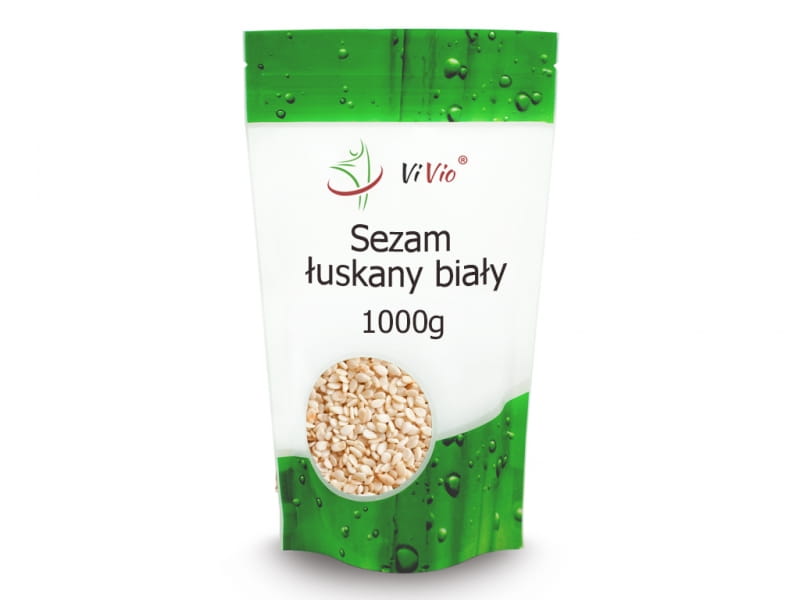Peeled white sesame 1000g - VIVIO
- Regular price
- €8,78
- Regular price
-
- Sale price
- €8,78
- Unit price
- per
Couldn't load pickup availability
Description
x Sesame is an annual plant belonging to the oilseed genus. It is a branching perennial with a trunk about 50 centimeters high. Interestingly, this plant is distinguished by large green leaves with jagged edges. For generations, the most valuable element of sesame has been its fruit, which contains seed sacs containing up to eighty tiny sesame seeds. The well-known grains are characterized by a flat, slightly oval shape and are usually about 3 mm in size. Immediately after being peeled from the capsule, they are white. Nevertheless, they take on a slightly creamy color over time.
Interestingly, sesame is one of the oldest oilseeds cultivated by humans. We find the first indications of this in sources that are even 4,000 years old. It is important to know that in ancient Babylon, small sesame seeds were considered a spice of the gods themselves. This product was also very popular in Africa, China and India, where even its new variety (Indian sesame) was bred. Although times have changed, sesame continued its popularity. Today it is grown extensively in India and China. Nevertheless, the countries of South and Central America and Sudan are also world producers of this delicacy.
Sesame has been a part of human life for so long that it has found a permanent place in our culture and even religion. In many cultures it is considered a symbol of happiness and health. No wonder, after all it contains a lot of vitamins and minerals. Among them, calcium, magnesium, phosphorus, selenium, zinc and iron deserve special attention. In addition, peeled sesame is able to provide our body with vitamins of the B group (including irreplaceable folic acid) . The most valuable thing about sesame seeds, however, are unsaturated fatty acids such as sesamol and phenolic sesaminol. In addition, these small grains contain plant phytosterols, which are necessary for the proper functioning of the circulatory system.
Shelled sesame has a sweet, slightly buttery flavor. It is also characterized by its extraordinary aroma, which is used not only in the kitchen but also in the cosmetics and pharmaceuticals industries.
COMPOSITIONS
white sesame
NUTRITIONAL VALUE OF THE PRODUCT IN 100 g
Calorific value - 2710 kJ / 656 kcal
fat - 60 g
- of which saturated fatty acids - 6.7 g
Carbohydrates - 2.1 g
- including sugar - 1.6 g
Fiber - 7.9 g
Protein - 23g
Salt - 0.03 g
NET WEIGHT: 1000 g
APPLICATION
Sesame is not only widespread in oriental dishes. Because of its unique taste and above-average nutritional value, we can use it in many ways in our kitchen;
- First of all: when preparing breakfast, it is perfect as an addition to porridge or homemade wholemeal rolls;
- Secondly, it is worth preparing a tasty tahini paste from it, which perfectly combines with the taste of natural yogurt and fresh fruit;
- Third, peeled sesame is perfect as a flavorful coating for chicken or as a crunchy addition to vegetable salads;
- Fourth, small sesame seeds can be added to homemade whole grain cookies or used to bake flavorful cakes.
Interestingly, small sesame seeds in combination with aromatic sesame oil can be used for leg massage, which also performs a nourishing exfoliating function.
RECOMMENDED STORAGE CONDITIONS
Store in a dry and cool place cu.
similar products
- Regular price
- €8,78
- Regular price
-
- Sale price
- €8,78
- Unit price
- per
- Regular price
- €8,78
- Regular price
-
- Sale price
- €8,78
- Unit price
- per
- Regular price
- €8,78
- Regular price
-
- Sale price
- €8,78
- Unit price
- per
- Regular price
- €8,78
- Regular price
-
- Sale price
- €8,78
- Unit price
- per
- Regular price
- €8,78
- Regular price
-
- Sale price
- €8,78
- Unit price
- per
- Regular price
- €8,78
- Regular price
-
- Sale price
- €8,78
- Unit price
- per
- Regular price
- €8,78
- Regular price
-
- Sale price
- €8,78
- Unit price
- per
- Regular price
- €8,78
- Regular price
-
- Sale price
- €8,78
- Unit price
- per
- Regular price
- €8,78
- Regular price
-
- Sale price
- €8,78
- Unit price
- per
- Regular price
- €8,78
- Regular price
-
- Sale price
- €8,78
- Unit price
- per
Recently Viewed Products
- Regular price
- €8,78
- Regular price
-
- Sale price
- €8,78
- Unit price
- per
- Regular price
- €8,78
- Regular price
-
- Sale price
- €8,78
- Unit price
- per
- Regular price
- €8,78
- Regular price
-
- Sale price
- €8,78
- Unit price
- per
- Regular price
- €8,78
- Regular price
-
- Sale price
- €8,78
- Unit price
- per
- Regular price
- €8,78
- Regular price
-
- Sale price
- €8,78
- Unit price
- per
- Regular price
- €8,78
- Regular price
-
- Sale price
- €8,78
- Unit price
- per
- Regular price
- €8,78
- Regular price
-
- Sale price
- €8,78
- Unit price
- per
- Regular price
- €8,78
- Regular price
-
- Sale price
- €8,78
- Unit price
- per
- Regular price
- €8,78
- Regular price
-
- Sale price
- €8,78
- Unit price
- per
- Regular price
- €8,78
- Regular price
-
- Sale price
- €8,78
- Unit price
- per
- Choosing a selection results in a full page refresh.











